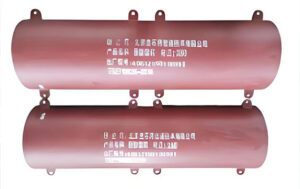External pipeline repair
External Pipeline Rehabilitation Engineering

After years of operation, pipelines inevitably develop corrosion damage and leaks due to material degradation and inadequate maintenance, causing significant economic losses. However, full pipeline replacement is often impractical due to:
- Massive construction requirements
- Prohibitive costs
- Extended project timelines
Advantages of External Pipeline Rehabilitation
Type B Sleeve Repair Technology

Type B sleeve repair is a permanent solution for oil and gas pipeline defects, offering broad applicability and significant technical value.
Product Structure
The sleeve consists of two semi-cylindrical halves that form a complete cylinder when assembled. Its inner diameter matches the outer diameter of the pipeline being repaired, allowing full encapsulation of the damaged section.
Technical Applications
Type B sleeves are designed to repair:
- Metal loss defects
- Pipeline deformations
- Weld imperfections (non-leaking)
Ideal for:
✔ Large-diameter pipelines (up to DN1500)
✔ High-pressure systems (≥10MPa)
✔ High-grade steel pipes (X70/X80)
✔ Thick-walled pipelines (≥20mm)
Key Benefits:
- Provides structural reinforcement
- Enhances pressure-bearing capacity
- Meets ASME B31.4/B31.8 standards


Key Points of Type B Sleeve Repair
For Type B sleeve repairs, the pressure at the pipeline defect must first be reduced to below 0.8 times the operating pressure to ensure welding safety.
All welds after sleeve repair should be inspected using non-destructive testing methods to guarantee repair quality.
Compared to Type A sleeve repair technology, Type B sleeve repair is more complex in process but offers advantages including shorter repair cycles, relatively lower repair costs, and less environmental damage.

Type A Sleeve Repair Technology for Oil & Gas Pipelines
Type A sleeve repair is a pipeline defect remediation technology with the following characteristics and applications:
Technical Features:
The Type A sleeve assembly consists of two semi-circular guard plates or properly curved plate segments. These components are installed over the pipeline defect area, with the repair completed by welding both side seams. The sleeve welding configuration may utilize either:
- Single-V groove butt welds, or
- A lap joint steel strip connecting the two semi-circular halves, with fillet welds applied between the strip and sleeve.
Critical Repair Procedures:
During installation, the sleeve must maintain full contact with the pipe wall surface.
Pre-heating of weld joints is mandatory before welding operations.
The annular gap between the pipe defect and sleeve must be filled with hardenable compounds (epoxy resins or polyester compounds).
Quality Assurance:
Post-repair, the longitudinal side welds do not require stringent non-destructive testing (NDT). This solution is primarily designed for minor pipeline defects.
Technical Limitations:
Due to structural constraints, Type A sleeves cannot be used for:
- Circumferential pipeline defects
- Active pipeline leaks


Carbon Fiber Reinforcement Repair Technology
During pipeline operation, corrosion and damage inevitably occur, necessitating timely repairs. Improper handling or delays in addressing these issues may lead to severe consequences.
Conventional repair methods include pipe replacement, welding, and clamp reinforcement. However, pipe replacement involves substantial engineering work, is time-consuming, and costly. For pipelines conveying flammable or explosive media, welding poses significant safety risks due to spark generation. Moreover, welding thin-walled pipes with multiple leak points carries a high risk of burn-through and may readily cause hydrogen embrittlement and cold cracking.
With the advancement of carbon fiber reinforcement technology, its applications have become increasingly widespread. This technology enables strength restoration of damaged pipeline sections without interrupting production, offering multiple advantages: no hot work required, continuous operation during repairs, online rapid repair capability, operational safety, minimal crew requirements, no need for heavy equipment, and cost-effectiveness. Most importantly, since this technology eliminates welding on in-service pipelines, it completely avoids risks associated with burn-through, hydrogen embrittlement, and cold cracking.
The carbon fiber repair system provides a reliable alternative that meets industry standards including ASME PCC-2 and ISO/TS 24817, while maintaining pipeline integrity and extending service life. This innovative solution is particularly valuable for high-risk environments where traditional welding repairs are prohibited or impractical. Field applications demonstrate its effectiveness in restoring full pressure containment capability while significantly reducing downtime compared to conventional methods. The non-metallic composite materials also provide excellent corrosion resistance, making them suitable for various operating conditions across multiple industries.



